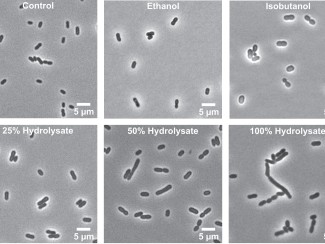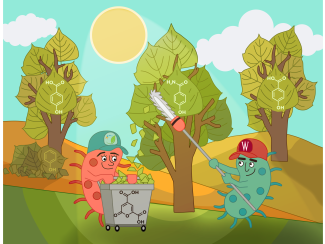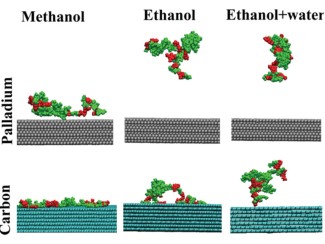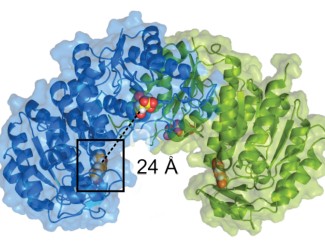Zymomonas mobilis tolerates high concentrations of ethanol, but just a little isobutanol stunts its growth

With its propensity to ferment sugar, environmental versatility, and streamlined genome, Zymomonas mobilis is a promising tool in the quest to turn plants into sustainable replacements for fossil fuels.
Zymomonas naturally produces ethanol, but with genetic modifications researchers have found ways to trick the microbe into making more valuable products like isobutanol, a form of alcohol that holds more energy and can more easily replace gasoline and jet fuel.
There’s one big hurdle, though: While Zymomonas tolerates high levels of ethanol, even a little bit of isobutanol will stunt its growth.
New research by University of Wisconsin–Madison scientists sheds new light on just how this alcohol makes Zymomonas sick, which could guide future efforts to engineer strains that can produce and tolerate isobutanol and other products.
The study is part of a wider investigation of Z. mobilis by the Great Lakes Bioenergy Research Center, a federally-funded hub based at UW–Madison working to develop cost-effective ways to make fuel and other chemicals from non-food plants.
It began with an observation that isobutanol exposure caused the normally rod-shaped cells to swell up like spheres, and that it changed the composition of the cell membrane, the microbe’s first line of defense.
“That pretty much told us that we need to dive a little bit deeper and see exactly what’s going on,” said Julio Rivera-Vazquez, a graduate student in Daniel Amador-Noguez’s lab and co-author of the paper published in the journal Biotechnology for Biofuels and Bioproducts.
A professor of bacteriology and co-investigator with the bioenergy center, Amador-Noguez studies the effects of environmental changes on microbial systems in part to advance biofuel engineering.

The team used a holistic approach known as omics to analyze how ethanol and isobutanol affect the microbe’s systems: the fatty acids that make up the cell membrane (lipidomics); the chemical reactions cells use to capture energy (metabolomics); and the array of proteins the cells produce (proteomics) in order to understand the effects of ethanol and isobutanol exposure.
They found that isobutanol has a much greater effect on the microbe’s overall function than ethanol. In particular, isobutanol exposure triggered a broad stress response, disrupting its metabolism and depleting resources needed for growth.
Even more interesting, when exposed to ethanol, the microbe made more of the fatty acids that form the cell membrane as well as the enzyme that produces them. Exposure to isobutanol caused it to make more of the enzyme but less of the fatty acids, which indicates isobutanol disrupts the chemical reactions the cells use to produce fatty acids.
By tweaking the bacterium’s genes the researchers were able to increase production of fatty acids and stress proteins, but the resulting strains didn’t grow much better when exposed to isobutanol.
Rivera-Vazquez said improving isobutanol tolerance likely requires a more holistic approach.
“Artificially increasing proteins in the cell is not the best way to do it,” he said.
Currently the team is pursuing another experiment using what’s called “directed evolution.” By growing Zymomonas cells while gradually increasing the concentration of isobutanol, they’ve developed a strain that tolerates slightly higher levels.
Next, they will analyze the more tolerant strain to see how its genome changed in response to the stress. The results could help researchers develop even more isobutanol-tolerant strains.





